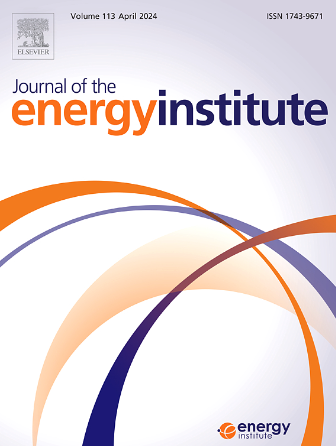Effect of promoters and calcination temperature on the performance of nickel silica core-shell catalyst in biogas dry reforming
IF 5.6
2区 工程技术
Q2 ENERGY & FUELS
引用次数: 0
Abstract
In this article, a facile ammonia evaporation method was adopted to synthesize a series of Ni-M-SiO2@SiO2 catalysts promoted with Ce, Zr, La, Co and Mg in order to examine the effect of promoters on the catalytic performance of the core-shell catalyst in biogas dry reforming. The obtained outcomes exhibited that rare earth oxide promoted catalyst displayed higher catalytic activity than the unpromoted catalyst. In addition, when the content of cerium oxide increased from 1 wt% to 5 wt% activity of the catalyst increased from 47.5 % to 57.2 % at 600 °C. Acquired results exhibited that, adding 1 wt% cerium oxide to Ni-SiO2@SiO2 led to improved dry reforming activity and decreased carbon formation during 12 h dry reforming reaction. 10Ni-1Ce-SiO2@SiO2 core-shell catalyst showed higher catalytic activity and lower coke formation than the (10Ni-1Ce)/SiO2 impregnated catalyst. This observation is because the shell of the catalysts provided steric physical barriers against nickel particles growth, also the nickel phyllosilicate structure posted chemical force that could fix the position of metal particles. The catalytic performance of the catalyst with 1 % cerium oxide was enhanced by enhancing calcination temperature from 700 to 900 °C owing to increase metal-support interaction.

求助全文
约1分钟内获得全文
求助全文
来源期刊

Journal of The Energy Institute
工程技术-能源与燃料
CiteScore
10.60
自引率
5.30%
发文量
166
审稿时长
16 days
期刊介绍:
The Journal of the Energy Institute provides peer reviewed coverage of original high quality research on energy, engineering and technology.The coverage is broad and the main areas of interest include:
Combustion engineering and associated technologies; process heating; power generation; engines and propulsion; emissions and environmental pollution control; clean coal technologies; carbon abatement technologies
Emissions and environmental pollution control; safety and hazards;
Clean coal technologies; carbon abatement technologies, including carbon capture and storage, CCS;
Petroleum engineering and fuel quality, including storage and transport
Alternative energy sources; biomass utilisation and biomass conversion technologies; energy from waste, incineration and recycling
Energy conversion, energy recovery and energy efficiency; space heating, fuel cells, heat pumps and cooling systems
Energy storage
The journal''s coverage reflects changes in energy technology that result from the transition to more efficient energy production and end use together with reduced carbon emission.
 求助内容:
求助内容: 应助结果提醒方式:
应助结果提醒方式:


